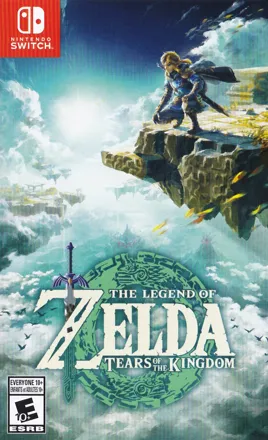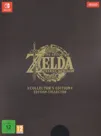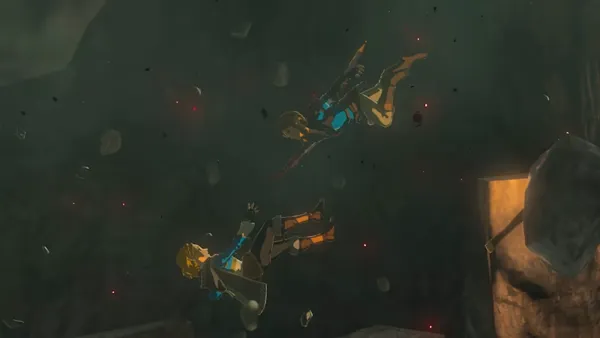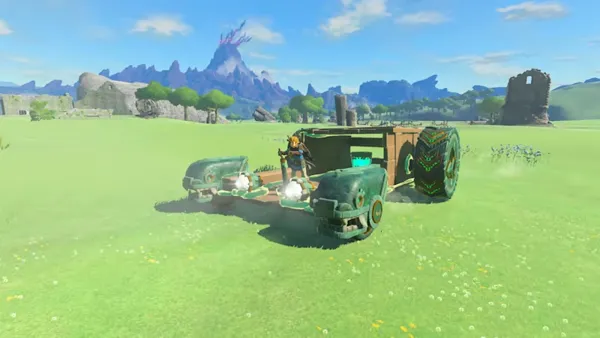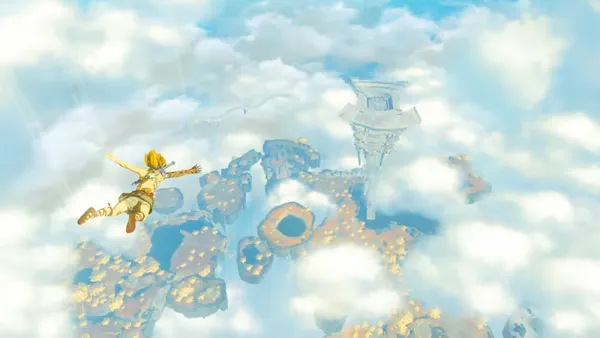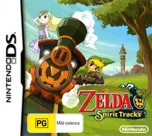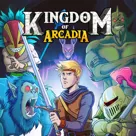The Legend of Zelda: Tears of the Kingdom
Description
Explore the vast land—and skies—of Hyrule
An epic adventure awaits in the Legend of Zelda: Tears of the Kingdom game, only on the Nintendo Switch system.
In this sequel to the Legend of Zelda: Breath of the Wild game, you’ll decide your own path through the sprawling landscapes of Hyrule and the mysterious islands floating in the vast skies above. Can you harness the power of Link’s new abilities to fight back against the malevolent forces that threaten the kingdom?
Explore
Link must travel across the far-reaching land and skies of Hyrule to discover the origins of the mysterious gloom that is plaguing the kingdom.
Create
Use Link’s powerful new abilities like Ultrahand and Fuse to make audacious weapons and craft creative ways to travel across the landscape.
Create
Discover
Find new ways to build, battle, and play as you try to uncover the secret menace that threatens Hyrule.
Spellings
- ゼルダの伝説 ティアーズ オブ ザ キングダム - Japanese spelling
Groups +
Promos
Videos
See any errors or missing info for this game?
You can submit a correction, contribute trivia, add to a game group, add a related site or alternate title.
Credits (Nintendo Switch version)
1,408 People (1,148 developers, 260 thanks) · View all
Reviews
Critics
Average score: 95% (based on 137 ratings)
Players
Average score: 4.5 out of 5 (based on 33 ratings with 1 reviews)
The Good
* The new abilities offer much greater flexibility and depth to traversal, combat, and puzzle solving.
-
Ultrahand lets you get really creative with objects in the world and build almost anything you want.
-
Though largely recycled from its predecessor, the game smartly remixes its old content with new surprises and changes.
-
Dungeons and boss fights are much improved over Breath of the Wild
-
The Sky Islands and the Depths add serious scale and content to the already impressively large world.
The Bad
* Technical performance issues -
While overall better, the dungeons may not be enough to satisfy classic Zelda fans.
-
Presentation and visuals still feel too retro at times.
-
Nintendo hasn't quite cracked non-linear storytelling yet.
The Bottom Line
Few games were as hotly anticipated for 2023 as The Legend of Zelda: Tears of the Kingdom. The seventh 3D game in the iconic series, Tears of the Kingdom is not only the direct sequel to 2017’s Breath of the Wild, it holds the record for the longest development cycle in the entire franchise. It has been over six years since a brand-new Zelda game has been released, without even a handheld entry to tide fans over. You would have to go back to the 1990s to find such a long gap between games, and the length of time between Breath of the Wild and Tears of the Kingdom is still longer than that. Still it’s finally here, and though the wait was far longer than anticipated given how much this game recycles from its predecessor, I have to say it was worth it. This is hands-down the best game I’ve played this year, and though the remaining months look to be jam-packed with quality titles, it’s hard to imagine anything else taking the top spot.
Tears of the Kingdom opens several years after Breath of the Wild, with Link and Zelda investigating a strange, newly-opened passage underneath the ruins of Hyrule Castle. After coming across a desiccated mummy emanating a red miasma known as “gloom”, Link and Zelda are attacked and get separated, with Zelda falling down into a fissure before disappearing. Link wakes up on a sky island somewhere above Hyrule, his arm replaced by a green cybernetic limb granting him several mysterious new abilities. As a result of the gloom and Link and Zelda’s actions, Hyrule has been altered in numerous ways by the cataclysmic event known as the Upheaval, resulting in numerous changes such as Hyrule Castle getting lifted into the air. Link must track down the whereabouts of the missing Zelda while also finding a way to combat the mysterious ancient evil which has taken over the land.
In terms of its story, Tears is generally more exciting that its predecessor, and much more of it happens directly as a result of the player’s actions. Unlike the previous game, it does not simply give away its mysteries from the jump, which is great since it means that basically every character in the game is just as in-the-dark as Link when it comes to wondering what is actually going on. That being said, while the story does have more urgency and more structure, it’s also horribly repetitive, particularly in the cutscenes which culminate the end of every dungeon, which literally offer the exact same exposition dump four times over. The story also utilizes the same structure where you can find various collectibles to trigger flashbacks that can be viewed in any order. All of this means that you’ll probably figure out the various twists way before the game actually intends you to, and while these twists are much more satisfying and unexpected than in the previous game, the story feels like it’s missing some of the depth that Breath of the Wild had. The game also muddies the series timeline even further to the point of irrelevancy, for those who actually care about that. Overall the story is a step forward in some ways, but. I don’t think Nintendo have quite cracked how to tell a wholly satisfying story in a non-linear fashion. That being said, it’s still a delight to catch up to the returning characters from Breath of the Wild and see what they are getting up to in this game. The game really leverages this aspect well, although there were a few characters whom I would have liked to have seen return.
Tears of the Kingdom has an extremely similar presentation to its predecessor, with characters speaking through text boxes along with grunts and sound bites to suggest their voice, with the occasional fully voice-acted cinematic cutscenes to spice things up. To be honest, I was honestly hoping for a bit more voice acting this time around considering that having fully-voiced characters are the standard in AAA games in 2023, but Nintendo have largely stuck to their guns here. What we do get is generally pretty solid for the most part, and there are some truly epic moments during the game’s cinematics. Still, it’s more than a little odd to see a character go from speaking full sentences during one moment then using a dialog box the next, even in the exact same camera shot. Nintendo really needs to ditch the N64-era presentation for future installments, or at the very least keep it consistent. Either give us one or the other, but not both!
Tears of the Kingdom is one of the rare direct sequels in the Zelda series, and as a result it uses many of the same fundamentals as its predecessor, right down to having the same map. It’s a rather unusual choice for a sequel, and though this might be a dealbreaker on paper, it’s anything but once you’re actually in the game. The landscape has changed dramatically due to either the Upheaval or the passage of time, and many of the areas you know from Breath of the Wild have been heavily altered. Part of the fun is returning to the places you knew and seeing how they changed, as well as learning about what familiar faces from the first game are getting up to now, now that several years have passed in-universe. Yet there’s so much more to this game than just a remixed map.
In terms of its general gameplay, Tears of the Kingdom follows very closely in the footsteps of Breath of the Wild. You’ll still explore the world searching for Shrines, which contain puzzles or challenges to earn points towards upgrading your Hearts of Stamina. You can climb practically any mountainside or surface, which means that if you can see it, you can go to it. You’ll still activate towers to unlock portions of the map, although the way you’ll interact with said towers is much different this time around, since they launch Link up high into the air. Weapon durability has, much to the chagrin of many players, returned. And yes, you’ll still need to search for Koroks to expand your inventory space.
This time around, there’s slightly more structure to the proceedings. Breath of the Wild allowed you to pursue Ganon as soon as Link jumped off of the Great Plateau, and while that is certainly possible here, Tears more strongly insists that you complete several objectives first before fighting the final boss. This makes Tears feel a bit more like one of the older Zelda games, though only just a bit, as the progression is still largely open, even if the path to actually completing the game is a bit more hidden from the player this time out.
Tears of the Kingdom is the triple-stacked sandwich of open worlds, with not one, but three distinct areas to explore: the Sky Islands, the surface, and the Depths. Each one of these roughly corresponds with a different pillar of gameplay. Together, these three layers complement each other in intriguing ways. The surface focuses mainly on exploration and side quests and is where you will spend the bulk of your time. The landscape now includes proper caves, which contain their own monster types, treasures, and resources to collect, sometimes house Shrines, and can even be used as a shortcut between areas. Admittedly, the game struggles to make each cave feel truly distinct from one another, but generally this is a fantastic addition.
In contrast, Sky Islands have a stronger emphasis on puzzle solving. Much of these floating ruins are modular and you’ll start to notice recurring elements such as Zonai relic dispensers and giant stone spheres as you explore them further, but as with the surface, there are certain types of resources and rewards that can only be found in the sky, including treasure maps which can point to the location of various special armor pieces. Most of your time in the air will be spent trying to devise ways to travel between each Sky Island, not too dissimilar to 2011’s Skyward Sword, although you won’t have the luxury of having a Loftwing at your beck and call. Some Sky Islands offer minigame challenges to complete, such as skydiving, which is a lot of fun. I do wish there was a bit more variety in terms of what you can actually find within the Sky Islands, as too many of them are ultimately too similar, but I still found them to be a good addition overall.
While you won’t find any Shrines or Koroks in the underworld, the Depths contain the toughest combat encounters, but also the most valuable gear and resources, including more durable weapons, Zonaite for building vehicles and increasing your Zonai battery capacity, and numerous armor pieces inspired by characters from past Zelda games. Going into the Depths is always something of a risk. For starters, the underworld is completely pitch dark until you start placing Brightbloom seeds to light things up. Your primary task is to search for Lightroots, connected to Shrines on the surface, which not only light up the Depths but also reveal parts of the map. The other factor that makes exploring the Depths challenging is that most enemies are afflicted with Gloom, meaning that taking damage from them can actually cause Link to lose hearts which can’t be restored unless you either find a Lightroot, eat certain kinds of food, or return to the surface. The Depths can also sometimes function as a means of travelling back to the surface world to reach otherwise inaccessible areas using Link’s Ascend ability. Some sidequests are designed to take you down into the Depths, and offer very nice rewards for completing them, including an ability that ends up being a huge timesaver. For the most part the Depths are a compelling and at times intensely atmospheric addition to Tears of the Kingdom, although the lack of visual and mechanical variety compared to the surface world or even the Sky Islands can be a bit grating if you stay down there for too long.
The other major aspect distinguishing this game from its predecessor are Link’s new core abilities, which completely change how you interact with the world. Gone are the Runes from Breath of the Wild, and this time around there are a host of new powers to play with. The Fuse ability lets you combine weapons, shields, and arrows with nearly any other object in the world: this not only enhances weapons’ durability, it also allows for different effects. Stick a rock onto a stick, and suddenly it’s a hammer, or stick a cart onto a shield and now it’s a skateboard. Discovering the possibilites of this system is a lot of fun, especially when you try out the more “wacky” combinations to see what could happen. This system not only makes collecting resources from fallen enemies much more essential, it also effectively replaces the different arrow types from Breath of the Wild, since resources in your inventory can be used to achieve similar effects, such as sticking a Bomb Flower onto an arrow to create a Bomb Arrow. Most weapons you find will be decayed and relatively weak, though stronger, non-decayed stuff in the Depths exists should you choose to go down there. There’s also Ascend, which lets Link fly up into any ceiling and pop out of the top, which makes vertical traversal so much nicer, and Recall, which allows an object to be sent backwards in time.
The real party piece has got to be Ultrahand. At first glance this seems to be a variation of Magnesis from the last game, except now Link is able to pick up pretty much anything that’s not nailed down. However, the real fun comes when you realize that objects can actually be attached together, letting you build so many different things. You’ll start out building bridges and platforms from logs, but eventually you’ll be able to use battery-powered Zonai artifacts to create various types of vehicles, from airplanes and hot air balloons through to cars, trucks, and even mecha and laser cannons. I will say that for as fun as this building system is, it can seem a bit inefficient at times. Most of the time, the simplest vehicles and solutions often work the best, anything that you build is temporary in the world, and when the game expects you to build something, typically most of the pieces will be available in a certain area. Despite this, building Zonai vehicles and other object often provide superior options for mobility and combat in many instances, making it a worthwhile system for imaginative players to take advantage of. The ultrahand system makes attaching pieces together very intuitive, and it works something like Lego. Much like Breath of the Wild, you can expect to see online videos showcasing stuff you didn’t know you could do for years to come.
Breath of the Wild’s dungeons were a huge point of contention for many longtime series fans including myself. While a great idea on paper, the Divine Beasts shredded too many conventions when in came to dungeon design. They were far too small and compact, all had the exact same theme, and the boss designs were similar. Tears attempts to fix a couple of those aspects and make some concessions towards fans of the older dungeons. For starters, the visual design of each dungeon is very different, and some of the new concepts are seriously cool, and too good not to spoil. The lead-up to each dungeon is also longer, more elaborate, and substantiative enough that you could technically consider each one a part of the dungeon in its own right. The boss designs feel much more in line with the old-school Zelda games, with each boss being a diverse enemy requiring very specific means to defeat them, and they range from jaw-dropping cinematic spectacles to genuinely challenging, nerve-racking encounters. You’ll even get a map with multiple floors to peruse, much like the older Zelda games. But at the end of the day, these temples ultimately hew very closely to the style of the Divine Beasts. You’ll typically begin in a central area and have to unlock several terminal by solving individual puzzles with the dungeon’s distinct mechanic, here provided by your companions, and each dungeon will take you roughly 20-30 minutes to solve. To their credit, these do a good job of taking advantage of this game’s more open design, but their small size and relative lack of complexity might be something of a bummer for those hoping for the second coming of Ocarina of Time’s Water Temple or the Ancient Cistern. I do believe Tears’ dungeons are generally superior to the Divine Beasts, and can be fun to solve, with the Wind and Lightning dungeons being real standouts in particular. Still, I miss the classic formula, and I would love for the series to find a way to properly bring back the classic-style dungeons in the future, without trying to meet players halfway.
The Nintendo Switch was already pretty outdated when it first launched, and six years later, it’s technical power languishes in the face of it’s newer, next-gen competitors. Despite that, Tears of the Kingdom is at times a true technical feat for the tablet console. The fact that you can jump from the sky, to the surface, and all the way down into the depths in one seamless motion without any loading screens at all is seriously impressive from a design standpoint. The draw distance is also much larger than Breath of the Wild’s. The physics engine functions pretty much as you would expect, with surprisingly little of the expected jank that usually comes from incorporating such a complex system in a game. That being said, there are a number of moments when the framerate dips pretty hard, and although some of the more problematic areas are better optimized than in Breath of the Wild, the performance can still be inconsistent where there are too many enemies and physics objects on the screen. It’s hard to argue that Nintendo hasn’t done a lot with their consoles’ meager specs, but I’m not going to lie, Tears of the Kingdom would definitely be an even better game on stronger hardware.
I might have come across as a bit more critical than expected given that I love this game, but it’s only because Tears does so many things well that the few things it doesn’t really stand out. Most of the issues from Breath of the Wild have been smoothed over, and its a much larger game to boot. Though it isn’t the perfect fusion of classic and modern Zelda that some perhaps have hoped for, it offers a number of refinements to the new formula and enough changes to the old content to make it worth playing regardless of how one might feel. Ultimately, Tears of the Kingdom made me remember why I remain obsessed with this series.
Nintendo Switch · by krisko6 (814) · 2023
Trivia
Awards
- The Game Awards 2023
- Game of the Year - Nominated
- Best Game Direction - Nominated
- Best Art Direction - Nominated
- Best Score and Music - Nominated
- Best Action / Adventure - Won
- 27th D.I.C.E. Awards (2024)
- Adventure Game of the Year - Won
- Game of the Year - Nominated
- Outstanding Achievement in Game Direction - Nominated
- Outstanding Achievement in Game Design - Nominated
- Outstanding Technical Achievement - Nominated
- 24th Annual Game Developers Choice Awards (2024)
- Game of the Year - Nominated
- Best Audio - Nominated
- Best Design - Nominated
- Best Technology - Won
- Best Visual Art - Nominated
- Innovation Award - Won
- 2024 BAFTA Games Awards
- Audio Achievement - Nominated
- Best Game - Nominated
- Game Design - Nominated
- Music - Nominated
- Narrative - Nominated
- Technical Achievement - Won
- EE Player's Choice Award - Nominated
Analytics
Upgrade to MobyPro to view research rankings!
Identifiers +
Contribute
Are you familiar with this game? Help document and preserve this entry in video game history! If your contribution is approved, you will earn points and be credited as a contributor.
Contributors to this Entry
Game added by Sciere.
Additional contributors: Plok.
Game added May 14, 2023. Last modified April 27, 2024.
